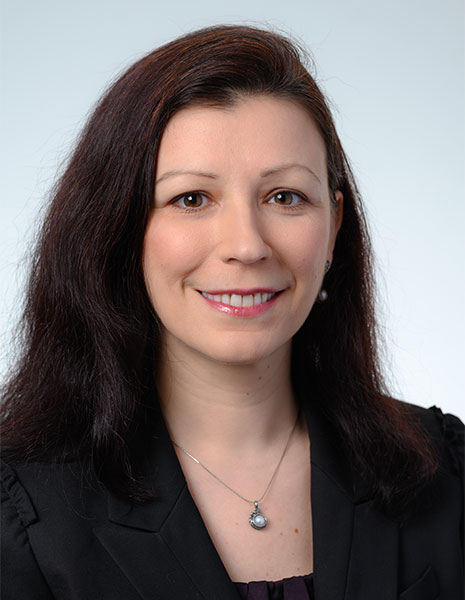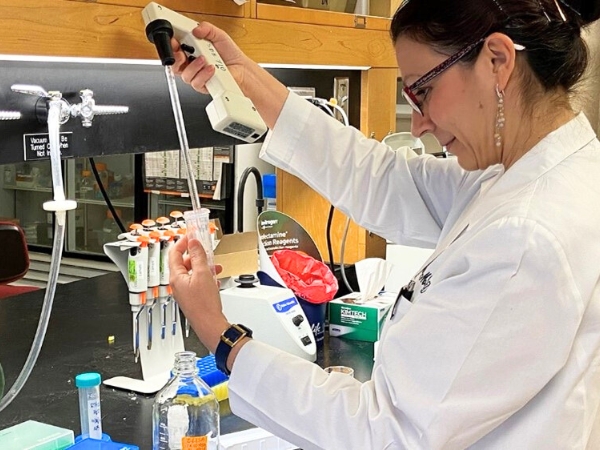During the early days of her dental training, Ejvis Lamani, D.M.D., Ph.D., discovered that peering into the mouths of her patients made her want to then go peer through the lens of a microscope. Ever since, Lamani’s career has combined the clinical and research sides of the profession, including for the past nine years as an assistant professor of Orthodontics with the University of Alabama at Birmingham School of Dentistry.
 A native of Albania, Lamani came to the United States in the 1990s to attend college at the University of Alabama, primarily because some family friends were living in Tuscaloosa. She received a Bachelor of Science degree in Chemistry in 1997, and later headed to the University of Iowa as a research assistant on a pre-med track.
A native of Albania, Lamani came to the United States in the 1990s to attend college at the University of Alabama, primarily because some family friends were living in Tuscaloosa. She received a Bachelor of Science degree in Chemistry in 1997, and later headed to the University of Iowa as a research assistant on a pre-med track.
While at Iowa, however, Lamani became friends with two students who had been accepted to dental school. And the more she talked with them about dentistry, the more she became interested in the profession.
“People in my family were in the medical field. There were no dentists,” Lamani says. “So dentistry was never on my radar until Iowa. But once I started learning about it, I thought it was interesting. I began volunteering and shadowing at a free dental clinic, and that was my introduction to dentistry.”
Eventually, Lamani says she took the Dental Admission Test “just to test the waters” before finally taking the plunge into dental school. She decided to return to Alabama and enroll in the UAB SOD because of her background in the state (“It felt like my second home,” she says) and because UAB offered a dual D.M.D./Ph.D. program, allowing her to pursue both her dental and research interests.
After receiving her dental degree, Lamani moved to San Antonio, Texas, for her orthodontic residency, with plans of joining an orthodontic practice. But once again, her path took an unexpected turn.
“While I was doing my residency, I noticed there were a lot of patients who had root resorption,” Lamani says, referring to the process in which the body absorbs tissue surrounding a tooth. “I wondered why there were so many. So, I started digging into it and found out that many of the patients had short root anomaly (a genetic dental developmental disorder), which a lot of people weren’t even aware of at the time. That’s when my interested in research resurfaced.”
 So instead of entering private practice, Lamani returned to Alabama yet again and joined the UAB SOD faculty in 2015. Within a year she received a grant from the American Association of Orthodontists Foundation to expand her research into dental genetic markers. Earlier this year she was awarded another grant from the AAOF to examine genes that potentially could affect root development and lead to root resorption.
So instead of entering private practice, Lamani returned to Alabama yet again and joined the UAB SOD faculty in 2015. Within a year she received a grant from the American Association of Orthodontists Foundation to expand her research into dental genetic markers. Earlier this year she was awarded another grant from the AAOF to examine genes that potentially could affect root development and lead to root resorption.
“I’m trying to identify genes that contribute to these disorders to see what the molecular signaling process is, and how we could potentially use this in the future to prevent some of the side effects when patients undergo orthodontic treatment,” Lamani says.
“What I really want to do is precision orthodontics, where we can modify our treatment so we don’t increase that risk for root resorption.
“I’m also looking at the potential association between tooth agenesis (congenital missing teeth) and cancer, because tooth development is linked to a lot of signaling pathways that are similar to cancer progressions. So one of the grants I’m applying for is looking to identify those common genes and mutations that we can screen for early in our patient population. Dentists are more likely than doctors to see patients on a regular basis when they’re young. If we know patients have a specific genetic pre-disposition, they can take steps and be screened and monitor it.”
Such research is crucial to the continued advancement of the overall dental profession, according to SOD Department of Orthodontics Chair and professor Chung H. Kau, B.D.S., M.Sc.D., M.B.A, Ph.D., which he says is why Lamani has become such a valuable member of the faculty.
“Clinical scientists in dentistry – folks who can both do the research and practice the science in a clinical environment – are a rare breed,” Kau says. “She is a great clinician and a great teacher, who is also playing a big role in our research endeavors.”
Lamani admits that conducting research at the UAB School of Dentistry was not part of her originally career plan when she first arrived in the United States. But now that she is established at UAB, Lamani says she has found the ideal professional home.
“UAB as a whole is a community that is supportive in both the clinical aspect of things and the research aspect, which helps my development,” Lamani says. “It feels like a family. Everybody is connected. And that network within UAB is what helps me move forward and continue toward reaching my goals.”
Dr. Lamani is a clinician scientist with advance training in Orthodontics specializing in craniofacial growth and development. Her interest lies on craniofacial biology and genetics with emphasis on dental development and related human genetic disorders. Her research aim is to translate the molecular biology and genetics of human growth and development to the treatment and future prevention of craniofacial and dental anomalies.